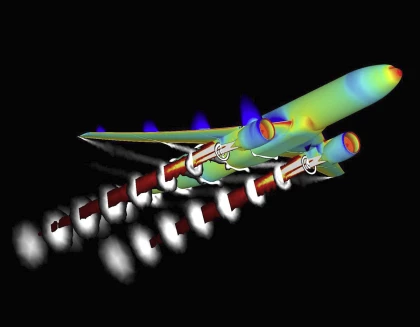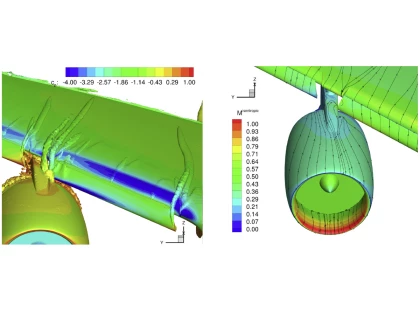
Background
Future aeroengines for long haul aircraft will benefit from increased propulsive efficiency by adopting Ultra-High ByPass Ratio (UHBPR) turbofans, to target the environmental requirements set by international institutions for the 2050 horizon. In fact, reducing the specific thrust has been long recognised as a possible way to improve propulsive efficiency and reduce fuel burn and CO2 emissions. However, the adoption of low specific thrust engine cycle to maximise propulsive efficiency leads to an increase in engine fan diameter and a consequential increase in nacelle size and weight if conventional nacelle design rules are followed.
To this purpose, innovative short and slim nacelles must be designed for UHBPR engines, provided that wave and spillage drag can be controlled over the whole aircraft mission. In addition, to fully enable the potential benefits of compact UHBPR advanced nacelles, it is necessary to enhance the ability to efficiently install the nacelle closer coupled with the wing, for structural efficiency and weight saving opportunities.
However, these configurations are outside current industry experience. In particular, the close coupled installations will result in significant three-dimensional interference effects over the aft nacelle, which may have a strong impact on the resulting drag and exhaust pressure field pattern. This is not considered in current nacelle design practices.
As such, innovative design and optimization rules accounting for these novel installation configurations and related effects are needed.
Strategy
IVANHOE is going to advance the state of the art in UHBPR nacelles design through the implementation of an innovative methodology to optimise both nacelle geometry and installation position, based on numerical and experimental investigations. This methodology will support a concurrent design process of wing, engine and nacelle which will make it possible to reach a global optimum in thrust/drag/lift performance and definitely enhance the fuel burn gains that can be realized from the more efficient UltraFan® engine cycle.
In particular, latest automated multi-point, multi-objective numerical design optimization techniques embedded in the HIT09 optimization platform GeDEA-II, combined with latest CFD installed drag and thrust prediction methods, and advanced parametric geometry procedures are to be brought together to enable novel, close coupled designs for installed 3D nacelle cowls, including pylons. Optimisation for a full cruise mission, over a range of power settings, will enable optimum nacelle pressure distributions and exhaust shock topographies to be identified both to minimise drag and maximise performance for a range of installed nacelle locations. The IVANHOE project addresses this challenge for two mission scenarios, i.e. short/medium range (Mach=0.80) and long range (Mach=0.85).
To calibrate the CFD methods for these novel nacelle designs, and to verify the performance benefits, an extensive wind tunnel campaign will be carried out in the transonic DNW HST wind tunnel, featuring novel powered nacelles which accurately model the engine exhaust flow field. A combined set of measurement techniques will be applied to capture all flow phenomena and provide validated and accurate understanding of the flow physics involved in optimized nacelle behaviour under installation effects. Test techniques like Infrared Thermography (IRT) for surface shockwaves, Oil flow visualization for surface flow topology, Stereo Pattern Recognition (SPR) for measurement of wing deformations, will be applied.
Finally, in addition to the cruise design point, a series of CFD studies will be conducted using the high-fidelity CFD code TAU, which will consider the nacelle performance under take-off configurations to confirm that the new designs can achieve acceptable aerodynamic performance under all operating conditions.
Outcomes
The project is currently on going. So far, the following results have been achieved:
The cycle models for UHBPR engine for both mission scenarios have been delivered;
The thrust and drag bookkeeping methodology has been finalized;
The baseline powered wing-body-nacelle-pylon configuration at both cruise and take-off has been released;
The engine simulator to be used in the wind tunnel tests has been selected and re-designed to adapt to optimal nacelles;
The optimal nacelles shapes and installation positions for both Mach=0.85 and 0.80 have been derived;
The measurement techniques to be used in the wind tunnel campaign have been defined.
Wind tunnel tests of optimized nacelles are planned in February 2022.
Duration: October 2019-September 2022
This project has received funding from the Clean Sky 2 Joint Undertaking (JU) under grant agreement No. 863415










